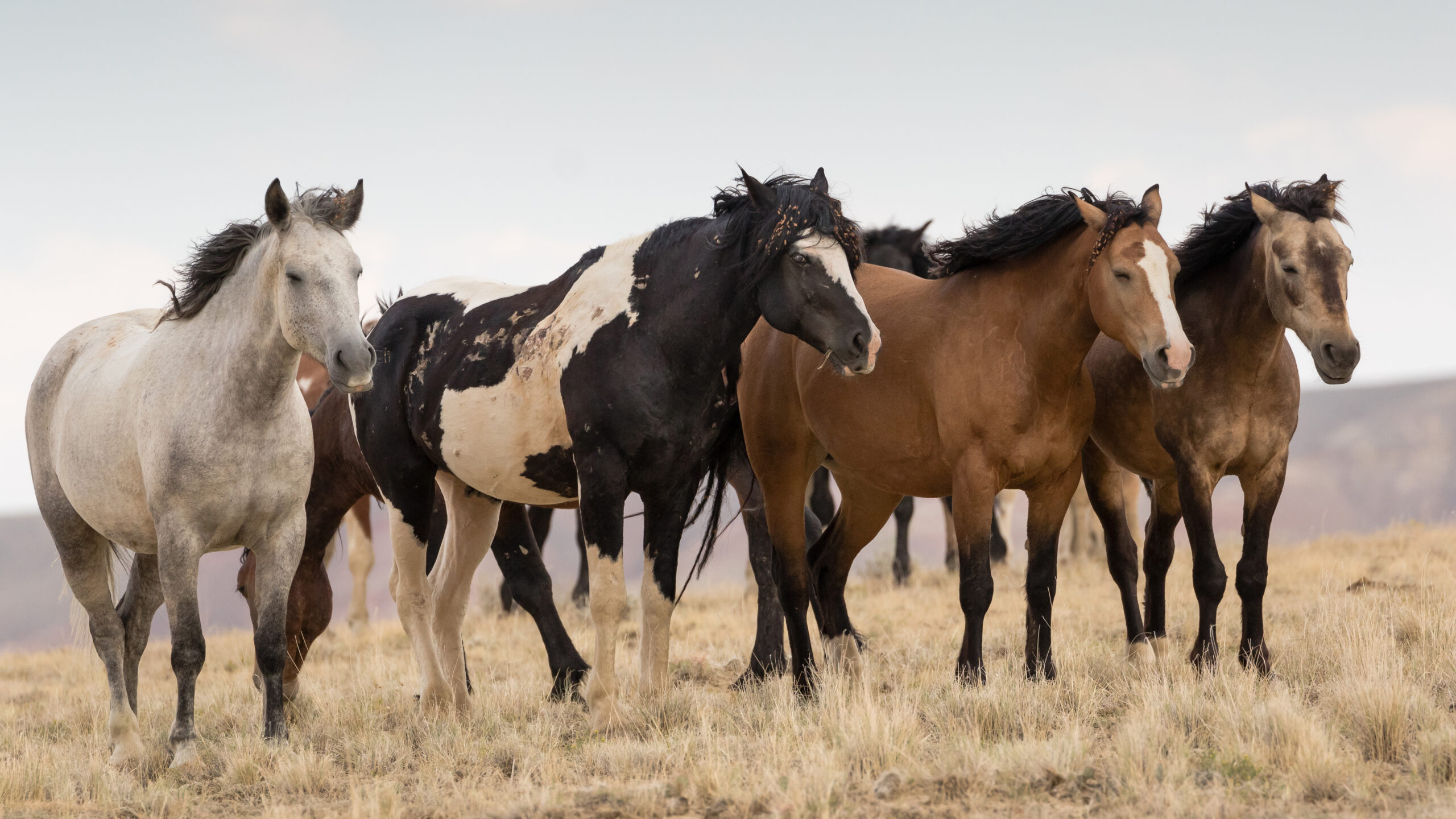Mustang Horse – Key Facts
- Species: Equus caballus
- Name: The Mustang Horse, or simply the Mustang.
- Height: Generally between 14 hands (56 inches/142 cm) and 15 hands (60 inches/152 cm)
- Weight: Usually about 800 pounds (360 kg), sometimes more.
- Appearance: The Mustang Horse is categorized as a light horse. Coat colors can be any, including solid colors, such as bay, brown and black. Many are sorrel, some dun, grulla, buckskin and palomino. Dorsal stripes are common. There are also spotted and paint Mustangs.
- Conformation: Variable. Many still show their Spanish horse ancestry.
- Special features: Mustang Horses are free-roaming animals. Every wild Mustang lives in a herd. These herds vary in size, and some are family groups. Because they are the feral descendants of once-domesticated horses, they have become very hardy over the centuries.
- Qualities: Mustang Horses have strong hooves. They survive and thrive on very basic grazing.
- Character: Having lived as wild horses needing to avoid predators, Mustangs are fast and intelligent. They adapt and learn quickly.
- Home: Mainly the Western United States, with small herds elsewhere on the continent of North America. They are also found in Central America.
Mustang Background
Thousands of years ago, the ancestors of modern horses roamed freely across what is now America. This was their original homeland, but they became extinct here about 8,000 years ago. The horse was reintroduced into the continent by the Conquistadors from Spain in the sixteenth century. Some of their domestic horses inevitably escaped and began to live wild again. These were given the name “mesteño” or mestengo, meaning stray in Spanish.
As other people began to settle in America, from Britain, Ireland, Europe, and Scandinavia, they brought horses, too, and some of these animals also escaped. The modern Mustang Horse descended from many of these original horse breeds, making it a feral animal rather than a wild one. Nature, too, has played a part in creating these wonderful horses. Living wild on the land over the centuries, the animals became very hardy, wily, and tough. They also became a symbol of the American West and an important part of its history. Mustang Horses have featured in plenty of movies, TV series, and books.
How big is a Mustang?
Mustangs are small to medium-sized animals, categorized as light horses or ponies. They are not tall but are sturdy and strong.
Mustang Horse – Characteristics
Like all horses, Mustangs are individuals, and most are independent-minded horses. This is due to their intelligence and strong survival instinct. If wrongly treated, they can be difficult. With the right person, though, they are loyal and willing. These very smart, sure-footed horses can make some of the best trail horses around. Health-wise, they are strong and enduring. They are famous for the superb quality of their feet and the strength of their bones.
Mustang Care and Feeding
Mustang Horses in the wild have learned to live on sparse grazing. They travel long distances to find food and water. These conditions are what have made the Mustangs some of the healthiest horses around. It’s important to make sure their grazing is not too lush and they have lots of space to move in.
How many Mustangs are there?
In July 2021, the Bureau of Land Management estimated that there were around 86,000 free-roaming horses on 28 million acres of public land within 10 Western US states. At this time, 55,000 horses had been removed from the land to live in government holding centers. Mustangs are also in private hands.
Where do Mustangs Live?
Wild, or rather, feral, Mustangs range over vast areas of land in the American West. They roam freely in herds of various sizes. There are also “pockets” of land where distinctive Mustangs live, such as the Kiger Mustangs of Oregon. The Pryor Mustangs of the mountains of Wyoming and Montana may have been living in that location since the 1600s.
The Cerbat Mustangs of Arizona are another well-established group. DNA analysis has revealed the Spanish ancestry of these lovely animals. While there are other feral horses in the USA, including on the east coast, they are not usually called Mustangs.

Mustangs generally stand between 14 hands (56 inches/142 cm) and 15 hands (60 inches/152 cm) and Weigh Usually about 800 pounds (360 kg), sometimes more.
Life in the Herd
A herd of Mustang Horses consists of a relatively small number of mares (around 8 to 12) and a stallion. While the stallion is often considered to be the leader of the herd, in fact, most of the herd’s daily routine is controlled by the lead mare. This mare makes decisions about where to graze and when to move to find water. The mares have foals at foot, often until they are yearlings when the mare has her next foal.
Then, the youngsters usually leave; the males to form bachelor groups, and the females to join the herd of another stallion. The massive herds that can be seen galloping madly in Westerns are not displaying the usual behavior of Mustangs. Feral horses spend a lot of their time grazing quietly and only run away in large groups when they are frightened by predators.
Why are Mustangs caught in the wild?
Mustangs are caught in the wild because many people are concerned about their numbers. With no natural predators, the on-range herds can quickly grow very large. They are caught to be rehomed and to reduce numbers.
Video of Mustang horses
Conservation of the Mustang: the Issues
Horses were an essential part of daily life for ranchers in the West. The large herds of feral horses were a useful resource for them. In 1971, the Mustang Horse received recognition for its important contribution to history and culture.
Congress described the horses as living symbols of the West. They had not only been important to European settlers, but also to native Americans. Today, the Mustang Heritage Foundation continues to campaign for recognition of these unique horses and their welfare. The free-roaming horses are managed by the Bureau of Land Management. Their activities sometimes bring the organization into conflict with campaigners
How much does a Mustang cost?
This depends on whether it is an unhandled Mustang from the range or a trained Mustang. The Bureau of Land Management is currently paying people an incentive of $1000 to adopt a range Mustang. This is a very recent and controversial move. Mustangs that take part in top-level competition command thousands of dollars.
Is a Mustang the Right Horse for You?
In the right hands, there are few horses as willing and intelligent as a Mustang. However, it takes time, commitment, and knowledge to bring out the best in them. An older Mustang that has been living a feral life is rarely suitable for a novice. Younger Mustangs may be more trainable. Mustangs that have lived on-range react differently to horses that have always known humans.

